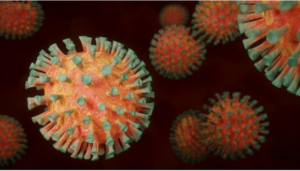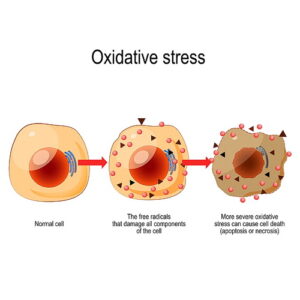What Happens When Foreign Agents Enter Your Body?

A virus infiltrates healthy cells, then makes copies of those infected cells and distributes them throughout your body. The coronavirus is no exception, but in this case, these bad cells concentrate mostly in and around your lungs; hence, the virus is considered a respiratory illness that is spread via droplets (coughs or sneezes) from an infected person to a non-infected person.
COVID and Other Respiratory Viruses
Most people who have died from COVID experienced respiratory complications that led subsequently to lung failure or cardiac arrest.
In most respiratory infections, a person’s lungs (as well as many other parts of the body) are damaged due to free radicals (atoms with missing electrons) released into the thoracic cavity, inflaming the lungs and creating oxidative stress. And since SARS-CoV-2, SARS and the influenza viruses have a similar structure, it is reasonable to assume that the mechanism that sets them off (medically called pathogenic mechanism) may be the common denominator of them all.
This means that COVID patients who develop lung problems were found to be attacked by the free radicals, the same as those that are found in the SARs viruses. But despite the obvious link, there hasn’t been much discussion or research on the subject. Moreover, all the current preventive measures and treatment protocols circulating worldwide fail to mention or tackle the virus-induced free radicals.
Only one major study has been conducted on the issue of free radicals in COVID patients by Professor Jun Wu, in which he has examined their role such as superoxide, hydroxyl radicals, nitric oxide (NO), and peroxynitrite in organ failure, cell death and other complications in COVID patients. To help you understand the damage caused by these compounds and how that ties with oxidative stress, we have provided an analysis of the study mentioned above.
The Free Radical Storm in COVID
The coronavirus is mediated by pro-inflammatory cytokines, (small secreted proteins that have a specific effect on the communication between cells) which trigger an immune response in the body and stimulate the generation of free radicals. In simple terms, they are the proteins that make the SARS-CoV-2 release an inflammatory cytokines storm in the thoracic cavity, swelling up the lung tissues. This inflammation activates a hyperimmune response in the body, signaling immune cells to reach the site.
Stages in COVID and Relevant Treatments
Study shows that the coronavirus infection progresses in three stages. In the first one, the virus attacks the body. In the next phase, a chain reaction from the virus leads to the release of toxic free radicals such as nitric oxide. And once the destructive compounds are free in the body, they react with healthy cells, creating oxidative stress in the lungs.
What is oxidative stress?

By the time COVID patients are hospitalized, their infection has already progressed to level 2 or 3, which means they have harmful radicals running in their system. During the said stage, administering antiviral drugs isn’t going to make much difference. Instead, medical experts should tackle the real culprit responsible for the respiratory deficits; free radicals. And the way to do that is by inducing antioxidants and potent free radical scavengers to eliminate the destructive compounds.
Tackling Free Radicals and The Damage Caused
Superoxide dismutase or SOD is an antioxidant that has been reported to tackle harmful free radicals during scientific research in lab rats. But unfortunately, SOD for clinical use isn’t available currently; therefore, it cannot be administered to people facing lung damage due to free radicals. That said, other compounds can be used in place of SOD that mimic the chemical composition and pathways of Superoxide dismutase.
Giving Antioxidants
Natural antioxidants can also be administered to COVID patients suffering from complications. Vitamin C and E are known to be incredibly effective antioxidants and free radical scavengers. Those could be used to suppress the damage caused by nitric oxide and superoxide. Studies have shown that vitamin C significantly reduces symptoms of the common cold when given orally to patients.
COVID and the common cold are vastly different from one another in the severity of symptoms and the scale of free radicals produced, so naturally, the vitamin C dosage that has shown to be efficacious in the case of the common cold will not be enough for people suffering from the coronavirus. Plus, the short lifespan of vitamin C in the bloodstream means a small amount cannot be sufficient for tackling the damage caused by free radicals in the body. That said, significantly large doses of vitamin C, introduced into the body intravenously, can work as a therapy for radical damage to the lungs in COVID patients.
Natural Defense Mechanism in the Body
Nrf2 is a natural antioxidative agent in the body that can fight destructive compounds. However, since its amount decreases with age, older patients cannot use their natural mechanism to minimize and tackle the impact of free radicals in the body. For elderly patients, Nrf2 activators should be injected into the body to revive the body’s natural fighting mechanism. Aside from that, large doses of antioxidants, such as zinc, should be given. Zinc is a potent antioxidant and a cofactor in SOD; administering it into COVID patients as combination therapy with other antioxidative compounds can help with the oxidative stress and damage caused by free radicals.
Final Thoughts
Although there hasn’t been enough research on antioxidants as a treatment for COVID, the little scientific evidence available suggests that it can work. Let’s see when the medical experts start to think in that direction.
